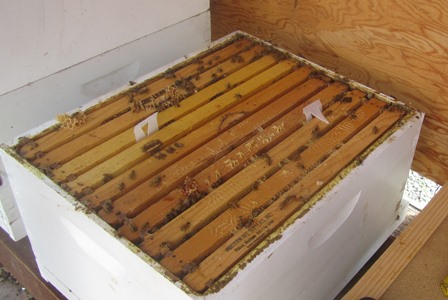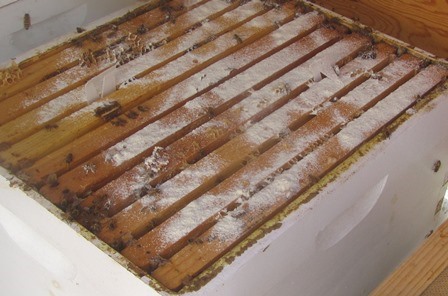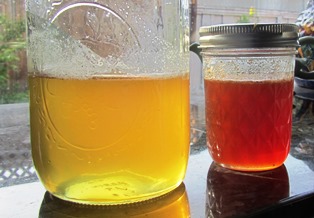Preparing Honeybee Hives for Spring
Recently, I conducted a mid-winter check of my honeybee hives. With my beekeeper neighbor’s help, we opened my Henny Penny Farmette Hives A and B to search for signs of an increase in the mite population, the presence of other pests, and evidence of mold. Inspecting and treating bees with medicines when necessary are important bee management practices.
We found one bug that I couldn’t identify but my neighbor explained it lays a narrow worm and must be removed before its numbers increase. This we did. We also found three frames in Hive B that had a few spots of mold. We threw away the frames and replaced them with wax-covered frames in the lower hive box where the queen had already produced lots of bee babies.
There appeared to be adequate stores of honey, baby bee food, and lots of baby bees. In fact, we removed a few frames of honey from both hives. In their place, we inserted frames that previously had the honey drained off but wax left intact (these I always freeze before putting back into hives since freezing kills mites, larvae, and wax moth), making it easier for the bees to start building comb.
The honey I harvested is dark-colored and earthy tasting, typical of autumn honey when the bees collect pollen from eucalyptus, star thistle, and other sources available in autumn. In contrast, spring honey is light-colored and slightly citrus tasting from pollen gathered from blooming citrus trees and wildflowers.

Hang medicated miticide strips between frames inward from the edge of the hive box for mite control.
Since we found evidence of mites, we hung miticide strips between frames to combat tracheal and Varroa mites. Also, we sprinkled powdered sugar medicine (Tetra-Bee Mix 2X Medicated) over the frames to control risk of American foulbrood. Treating the hives thus will enable the bees to remain robust. I expect their numbers to swell with warmer weather which, in turn, translates to new swarms in the spring.
*Apivar is an effective treatment of Varroa mites. One strip per four to five frames works through contact and should be placed in high bee activity areas. Not to be used when honey supers (top hive boxes with frames of honey) are on.
*Tetra-Bee Mix 2 X Medicated is recommended for control of American foulbrood caused by paenibacillus larvae and European foulbrood caused by streptococcus pluton susceptible to oxytetracycline in bees when used as directed.
For more beekeeping tips, delicious recipes, and a wholesome whodunnit, check out my Henny Penny Farmette cozy mysteries: A BEELINE TO MURDER (paperback release in October 2016), MURDER OF A QUEEN BEE (hardcover October 2016), and HIVE OF HOMICIDES (October 2017). Find them on Amazon.com, Barnesandnoble.com and other online and conventional bookstores everywhere.
Tags: American foulbrood, Apivar, bee baby food, bee medicine, citrus, eucalyptus, European foulbrood, honey, honeybees, mites, miticide, miticide strips, organic, powdered sugar, star thistle
 Facebook
Facebook Goodreads
Goodreads LinkedIn
LinkedIn Meera Lester
Meera Lester Twitter
Twitter







